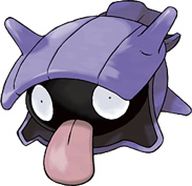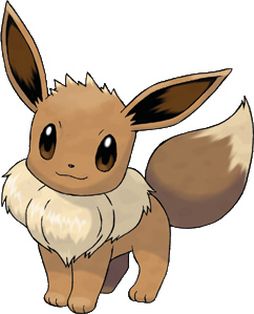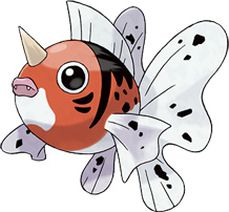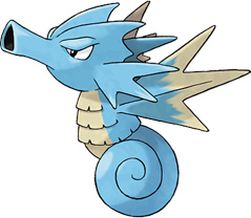
Shellder is similar to the clam, with its tongue representing a clam’s “foot.” The fact that it latches onto Slowpoke and produces a beneficial toxin may be inspired by leeches.
Shellder is derived from shell and possibly shelter, referring to the fact that it lives in a shell.
No: 090
English Name: Shellder
Japanese Name: Sheruda
Generation: 1
Type: Water
Species: Bivalve Pokémon
Abilities: Shell Armor, Skill Link, Overcoat (hidden ability)
Evolution: Shellder > Cloyster
Shellder is a black pearl-like Pokémon encased within a spiky, blue-violet bivalve shell. It has two round white eyes with tiny black pupils. It has an enormously long red tongue, which it uses to burrow itself into sand and to lure and capture prey. Its body is known to be soft and tender; however, its shell is said to be harder than diamond. Prehistoric Shellder were apparently preyed upon by Omastar. Once ensnared by Omastar’s tentacles, its hard shell stood no match to the Spiral Pokémon’s deadly powerful bite, and its soft insides quickly devoured.
Shellder can develop a symbiotic relationship with Slowpoke. After attaching itself to the Dopey Pokémon’s tail, the two undergo a metamorphosis and together evolve into Slowbro. If it attaches to the head of a Slowpoke in possession of a King’s Rock, the two will instead evolve into Slowking. These relationships allow it to travel onto land and obtain a new stage in its life cycle.
Regardless of which form the two Pokémon evolve into, Shellder’s shell transforms into a spiny, spiraled cone with several tiers. Sharp teeth develop around the rim of the shell to anchor it securely to the evolved Slowpoke, and its eyes now peek out from the bottom rim of the shell. In its crown form, Shellder will have a red jewel on its underside and a large horn on either side of its shell.
While in its crown form, Shellder will periodically release its venom into Slowking’s brain. This is actually beneficial to Slowking, as it causes the Regal Pokémon’s intelligence to increase. Higher quantities of venom intensify this effect, and Shellder is easily provoked into releasing more whenever Slowking yawns.
Shellder has two former signature moves. It can shoot spears of ice by using Icicle Spear, or clamp tightly to its opponents using Clamp. Despite its hard shell, clamping on to an opponent will reveal its vulnerable parts. Because of this, it will only clamp itself to a foe as a last resort. It swims around its sea floor home by rapidly opening and closing its shell while facing backward.
POKEDEX ENTRIES
Pokemon Red: Its hard shell repels any kind of attack. It is vulnerable only when its shell is open.
Pokemon Blue: Its hard shell repels any kind of attack. It is vulnerable only when its shell is open.
Pokemon Yellow: The shell can withstand any attack. However, when it is open, the tender body is exposed.
Pokemon Stadium: Its shell is harder than diamond. It hides in sand on the sea floor and catches prey with its soft tongue.
Pokemon Gold: It swims facing backward by opening and closing its two-piece shell. It is surprisingly fast.
Pokemon Silver: Grains of sand trapped in its shells mix with its body fluids to form beautiful pearls.
Pokemon Crystal: Clamping on to an opponent reveals its vulnerable parts, so it uses this move only as a last resort.
Pokemon Stadium 2: It swims facing backward by opening and closing its two-piece shell. It is surprisingly fast.
Pokemon Ruby: At night, this Pokémon uses its broad tongue to burrow a hole in the seafloor sand and then sleep in it. While it is sleeping, Shellder closes its shell, but leaves its tongue hanging out.
Pokemon Sapphire: At night, this Pokémon uses its broad tongue to burrow a hole in the seafloor sand and then sleep in it. While it is sleeping, Shellder closes its shell, but leaves its tongue hanging out.
Pokemon Emerald: At night, it burrows a hole in the seafloor with its broad tongue to make a place to sleep. While asleep, it closes its shell, but leaves its tongue hanging out.
Pokemon FireRed: It is encased in a shell that is harder than diamond. Inside, however, it is surprisingly tender.
Pokemon LeafGreen: Its hard shell repels any kind of attack. It is vulnerable only when its shell is open.
Pokemon Diamond: It swims backward by opening and closing its two shells. Its large tongue is always kept hanging out.
Pokemon Pearl: It swims backward by opening and closing its two shells. Its large tongue is always kept hanging out.
Pokemon Platinum: It swims backward by opening and closing its two shells. Its large tongue is always kept hanging out.
Pokemon HeartGold: It swims facing backward by opening and closing its two-piece shell. It is surprisingly fast.
Pokemon SoulSilver: Grains of sand trapped in its shells mix with its body fluids to form beautiful pearls.
Pokemon Black: It swims backward by opening and closing its two shells. Its large tongue is always kept hanging out.
Pokemon White: It swims backward by opening and closing its two shells. Its large tongue is always kept hanging out.
Pokemon Black 2: It swims backward by opening and closing its two shells. Its large tongue is always kept hanging out.
pokemon White 2: It swims backward by opening and closing its two shells. Its large tongue is always kept hanging out.
Pokemon X: Its hard shell repels any kind of attack. It is vulnerable only when its shell is open.
Pokemon Y: Clamping on to an opponent reveals its vulnerable parts, so it uses this move only as a last resort.
Pokemon Omega Ruby: At night, this Pokémon uses its broad tongue to burrow a hole in the seafloor sand and then sleep in it. While it is sleeping, Shellder closes its shell, but leaves its tongue hanging out.
Pokemon Alpha Sapphire: At night, this Pokémon uses its broad tongue to burrow a hole in the seafloor sand and then sleep in it. While it is sleeping, Shellder closes its shell, but leaves its tongue hanging out.
Pokemon SUN: The hardness of its shell surpasses the hardness of a diamond. In days gone by, people used the shells to make shields.
Pokemon MOON: This Pokémon’s tongue is always hanging out. It uses its tongue with great dexterity to dig up sand from the seabed in its search for food.



